The renowned New Mexico archaeological site known as Ghost Ranch has recently revealed a fossil that sheds some light on one of the most obscured periods in history, the time in the Triassic Age when the dinosaurs' evolution became clouded in mystery. The newly discovered animal, Tawa hallae, is one of the best preserved dinosaur skeletons from the Late-Triassic time period ever discovered, experts who have had a chance to look at the specimen say. What the small dinosaur did from well beyond the grave was unite all carnivorous dinosaurs into one group, known as the theropods.
This group now includes vicious predators such as the famous Tyrannosaurus Rex, as well as birds, which have been proven for a long time to have descended directly from the giant lizards. The Tawa fossil revealed features that were common in several species that were living at the time, but also had several that were never encountered in its “contemporaries.” The finding also lends a lot of support to a scientific theory holding that dinosaurs originally evolved in a section of the Pangaea supercontinent that would become, millions of years later, South America, the National Science Foundation reports.
After dinosaurs first appeared, they started diversifying into three major groups, anthropologists say. The first was that of the theropods, the predators. The second included the massive sauropodomorphs, such as the Apatosaurus and Diplodocus, which could basically trigger small earthquakes by simply walking. The third comprised the ornithischians, a class of animals featuring distinctive body types. Of this group, the general public and popular culture are more familiar with the Stegosaurus and Triceratops. It was after this split, some 200 million years ago, that dinosaurs spread and conquered the Triassic world, extending their rule for more than 135 million years after that.
“Tawa gives us an unprecedented window into early dinosaur evolution, solidifying the relationships of early dinosaurs, revealing how they spread across the globe, and providing new insights into the evolution of their characteristics,” University of Texas in Austin (UTA) scientist Sterling Nesbitt, who has also been the lead author of the new study, explains. A paper detailing the findings appears in the December 11 issue of the top journal Science.
“If you have continents splitting apart, you get isolation. So when barriers develop, you would expect that multiple carnivorous dinosaurs in a region should represent a closely related, endemic radiation. But that is what we don't see in early dinosaur evolution. Tawa is a very good example of a fossil that fills in what we call a morphological gap,” the expert adds.
“Usually, early dinosaur specimens are not as complete or well preserved, so they spur a lot more questions than answers. Tawa is so well preserved that every bone we have, we can examine it in three dimensions. And we can analyze five of the skeletons this way, with examples of both mature and immature animals. This is just the tip of the iceberg. All dinosaurs share a common feature, an open hip socket, and you can dissect your Thanksgiving turkey and still see that original feature. But the earliest lineages that lie in between are far from understood,” Nesbitt concludes.

 14 DAY TRIAL //
14 DAY TRIAL // 

